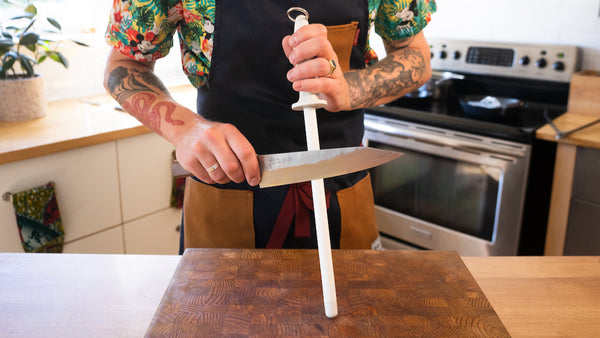How to Care for Your Brand New Japanese Knife (Or Any Other Knife)
So, you’ve brought home your new knife and you’ve been slicing through all the veggies and meat like a master chef! As with any high-performance tool, your new kitchen baby requires some simple maintenance to keep it in prime condition. Don’t worry, maintaining a Japanese knife is easy, and kind of fun!
How to Clean Your Kitchen Knife
Whether you have a high-carbon steel or stainless steel knife, you should get into the habit of washing off your knife with a damp soapy cloth or sponge, and drying it thoroughly after each use. Don’t let your new knife air dry especially if it’s made of high-carbon steel, as it can rust. Even stainless steel can rust if left wet for too long! Avoid using abrasive materials like steel scrubbies as they can scratch up your knife something fierce. Even a plastic green scrubby can leave scratches, so stick to a cloth or sponge.
Keep those babies out of the dishwasher! The extreme heat & moisture for an extended period is terrible for the knife and will cause major damage to both the handle and the edge. It can even cause stainless steel to rust, so always hand wash.
What to NOT Cut with Your Japanese Knife
You’ve heard us say it before, and we’re gonna say it again: Never cut anything you wouldn’t bite with your own teeth. Japanese steel is much harder than conventional knife steel, which is why it takes and holds an edge so well. It also means the knife will chip if you try to whack through bones or frozen food. Should you navigate around the bone and make sure you extract every juicy morsel of meat? Of course! Just don’t try and cleave through it.
Opening cans or prying apart frozen burgers are also no-nos. Use a can opener, or pull those burgs out of the freezer the night before. You’d think all this goes without saying, but we’ve seen some crazy things at the shops!
How to Cut with a Japanese Knife
The folks that made your knife worked very hard to get a perfect edge, and the easiest way to avoid chipping or dulling that blade is to cut straight. Try and avoid twisting, cleaving, or prising with the blade. Straight, even strokes will keep your knife in good shape, while also getting you those perfect cuts you so desire. You can learn more about good knife skills here, or book a knife skills class in one of our stores.
The Best Cutting Boards for Japanese Knives
The surface you cut on is the biggest culprit of dulling your knives. You want to feel as if your knife is slightly biting into the board. If the material is too hard and the knife is bouncing off of the surface, it will dull very quickly. We recommend wood or plastic cutting boards. In our shops we use sustainably-made Larchwood boards, which we find are made with the best materials for your knife. We also love the super-soft rubber boards from Hasegawa. Stay away from bamboo, marble, glass, slate and basically anything that’s harder than the steel in your knife.

How to Store a Japanese Kitchen Knife
You’ve likely got a drawer full of random kitchen utensils. Your knife will get damaged if it’s banging around in there with the other tools, so make sure to store it safely. Display that beauty on a magnet for all your friends to drool over, or in a knife block. If you must store it in a drawer, we have inexpensive plastic blade guards with a soft felt interior that keep your blades (and you) safe from harm! Grab a wooden saya if you want a more impressive sheath for your blade. Guards are a necessity if you store your blades in a knife-bag, the covers will keep your knives from slicing the canvas or leather to ribbons.

How to Keep Your Kitchen Knives Sharp
A honing rod is a must-have maintenance tool that will keep your knife sharp in between sharpenings. Think of it as a toothbrush for your knife: you brush your teeth everyday (I hope) and go to the dentist once or twice a year. Think of us, the knife sharpener, as the dentist. Between visits you gotta keep brushing, So hone that knife once or twice a week.
To use the honing rod, hold it vertically with the rubber end on a dishcloth on your counter (to avoid slipping) with your non-dominant hand holding the handle. Set your knife flush with the rod, then angle the spine 15 degrees off of the rod. The hilt of the honing rods we sell at Knifewear can help you get the angle correct. With gentle strokes, run the edge — from the heel to the tip of the knife, from top to bottom of the honing rod — alternating sides with each stroke.
If you are unsure of how to effectively use a honing rod, or if you have any further questions about how to care for your new beautiful knife, feel free to email, call or visit the shop anytime and ask. We are always happy to help.






